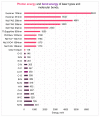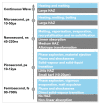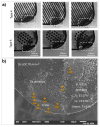Laser Processing of Hard and Ultra-Hard Materials for Micro-Machining and Surface Engineering Applications
- PMID: 34442517
- PMCID: PMC8402137
- DOI: 10.3390/mi12080895
Laser Processing of Hard and Ultra-Hard Materials for Micro-Machining and Surface Engineering Applications
Abstract
Polycrystalline diamonds, polycrystalline cubic boron nitrides and tungsten carbides are considered difficult to process due to their superior mechanical (hardness, toughness) and wear properties. This paper aims to review the recent progress in the use of lasers to texture hard and ultra-hard materials to a high and reproducible quality. The effect of wavelength, beam type, pulse duration, fluence, and scanning speed is extensively reviewed, and the resulting laser mechanisms, induced damage, surface integrity, and existing challenges discussed. The cutting performance of different textures in real applications is examined, and the key influence of texture size, texture geometry, area ratio, area density, orientation, and solid lubricants is highlighted. Pulsed laser ablation (PLA) is an established method for surface texturing. Defects include melt debris, unwanted allotropic phase transitions, recast layer, porosity, and cracking, leading to non-uniform mechanical properties and surface roughness in fabricated textures. An evaluation of the main laser parameters indicates that shorter pulse durations (ns-fs), fluences greater than the ablation threshold, and optimised multi-pass scanning speeds can deliver sufficient energy to create textures to the required depth and profile with minimal defects. Surface texturing improves the tribological performance of cutting tools in dry conditions, reducing coefficient of friction (COF), cutting forces, wear, machining temperature, and adhesion. It is evident that cutting conditions (feed speed, workpiece material) have a primary role in the performance of textured tools. The identified gaps in laser surface texturing and texture performance are detailed to provide future trends and research directions in the field.
Keywords: cutting tools; laser processing; laser-based micromachining; polycrystalline boron nitride; polycrystalline diamond; surface texturing; tungsten carbide.
Conflict of interest statement
The authors have no conflict of interest to declare that are relevant to the content of this article. All authors have reached agreement for publication.
Figures





























References
-
- Paul S., Singh R., Yan W. Lasers Based Manufacturin. Springer; New Delhi, India: 2015. - DOI
-
- Wu Z., Bao H., Xing Y., Liu L. Tribological characteristics and advanced processing methods of textured surfaces: A review. Int. J. Adv. Manuf. Technol. 2021;114:1241–1277. doi: 10.1007/s00170-021-06954-2. - DOI
-
- Denyer D., Tranfield D. The SAGE Handbook of Organisational Research Methods. Sage; London, UK: 2009. Producing a systematic review.pdf; pp. 671–689.
-
- Sumiya H., Harano K. Innovative ultra-hard materials: Binderless nanopolycrystalline diamond and nano-polycrystalline cubic boron nitride. SEI Tech. Rev. 2016;82:21–26.
-
- McKie A., Winzer J., Sigalas I., Herrmann M., Weiler L., Rodel J., Can N. Mechanical properties of cBN-Al composite materials. Ceram. Int. 2011;37:1–8. doi: 10.1016/j.ceramint.2010.07.034. - DOI
Publication types
Grants and funding
LinkOut - more resources
Full Text Sources
Miscellaneous

